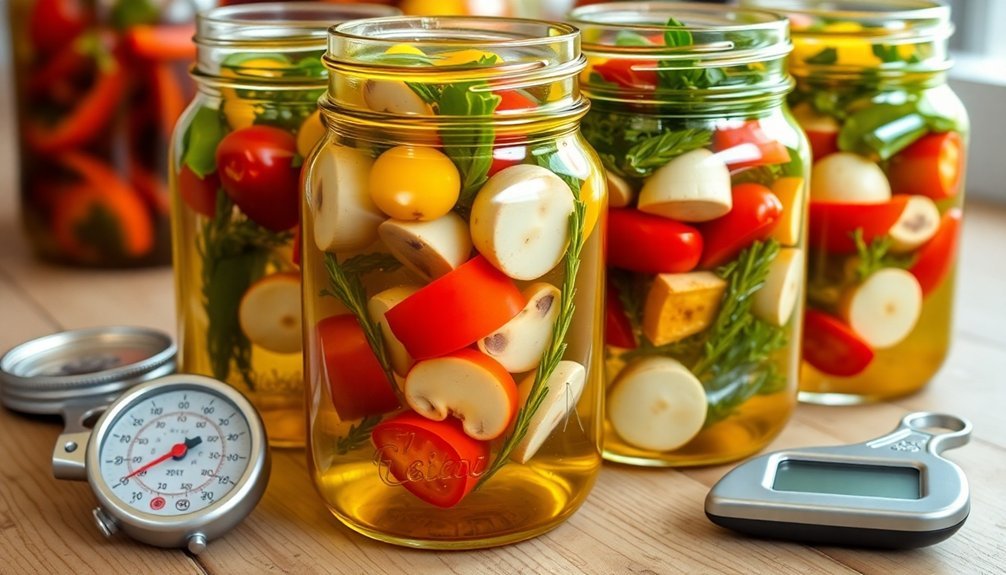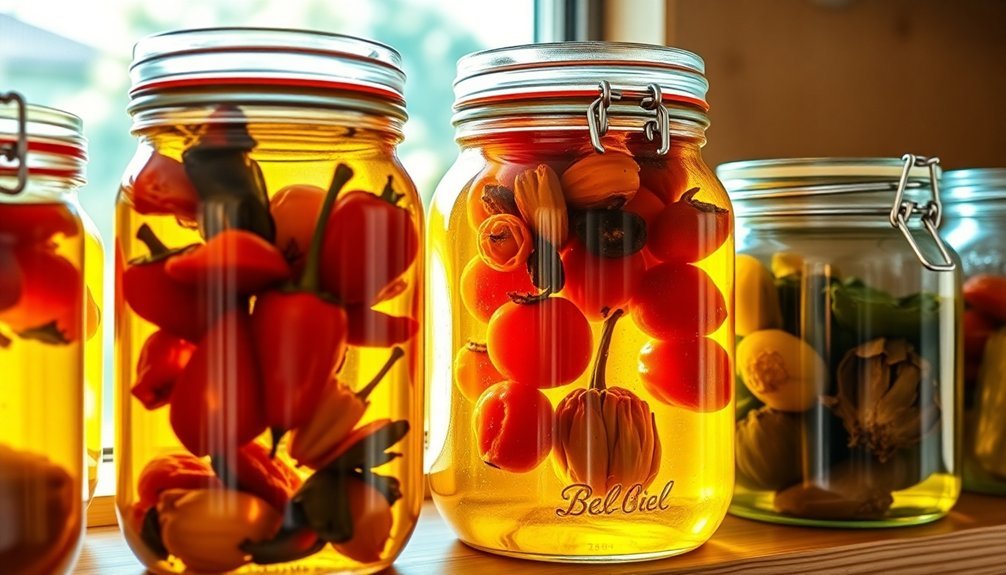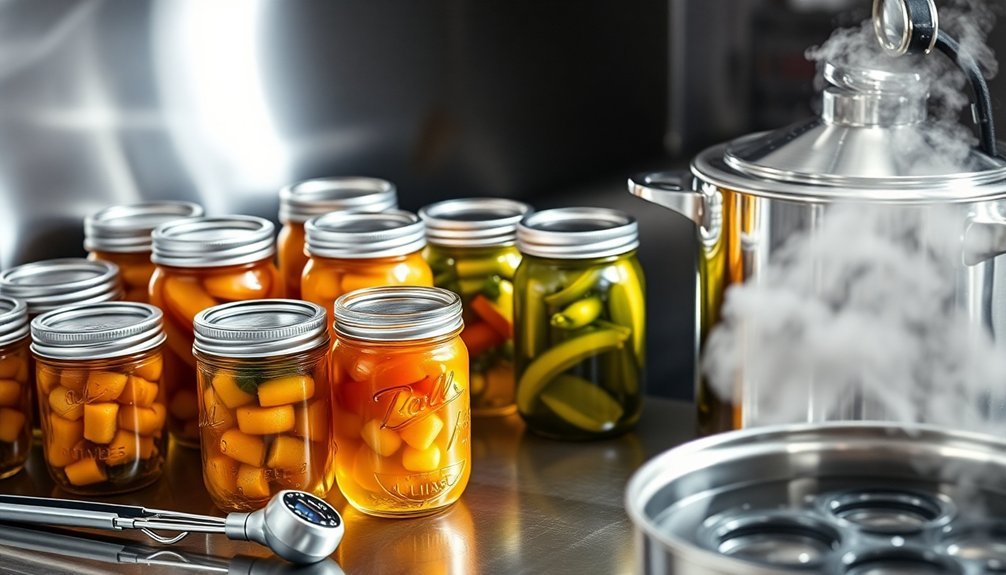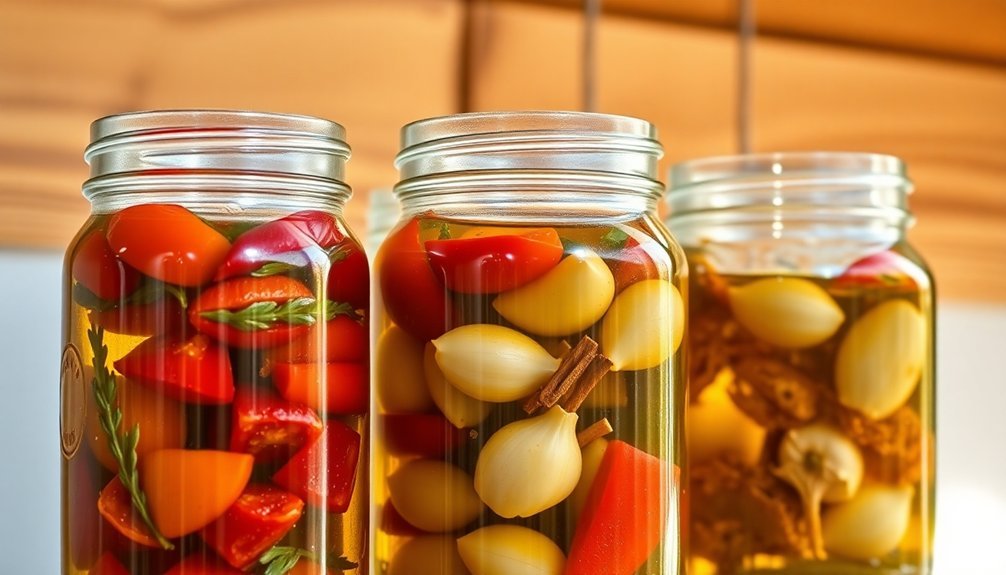To maximize your oil-packed vegetable storage, you'll need to follow five essential steps. Start by properly cooking your vegetables to deactivate enzymes and eliminate harmful bacteria. Mix your oil and vinegar in a 2:1 ratio, ensuring vegetables soak in vinegar overnight to achieve the right acidity. Store your preserved vegetables in dark glass or stainless steel containers with airtight seals, and keep them refrigerated between 32-40°F (0-4.4°C). Don't forget to maintain sterile equipment throughout the process. These fundamental principles will set you up for preservation success, but there's much more to explore about this time-tested technique.
Properly Cook Before Preserving

Proper cooking is essential before preserving vegetables in oil or vinegar solutions. You'll need to slow-roast, grill, or steam your vegetables to prepare them for preservation. This vital step not only tenderizes the vegetables but also deactivates enzymes that could affect their flavor, color, and texture during storage. Rapid boiling water is another effective method to prepare vegetables for preservation.
When you're planning to store vegetables for more than a week, don't include raw components like garlic or herbs, as they can compromise the safety of your preserved goods. Raw ingredients can introduce harmful bacteria and microorganisms, disrupting the acidic environment needed for proper preservation.
You'll want to cook your vegetables thoroughly to remove surface dirt and microorganisms while brightening their colors and slowing down vitamin loss. The cooking process also helps wilt greens and soften firmer vegetables, making them easier to pack into jars.
After cooking, cool your vegetables quickly to halt the cooking process and prevent nutrient loss. Once cooled, pack them into sterile jars and cover completely with your oil-vinegar mixture.
Remember to refrigerate your preserved vegetables to maintain their quality and prevent bacterial growth.
Master The Oil-Vinegar Ratio
The correct oil-vinegar ratio stands as a cornerstone of safe vegetable preservation. You'll need to maintain a 2:1 ratio of olive oil to vinegar to create a protective barrier that keeps harmful bacteria at bay. Using B.S.G. olive oil provides the best preservation results.
It's essential to understand that vinegar's acidic properties are your primary defense against dangerous organisms like Clostridium botulinum.
When preparing your vegetables, always start with the vinegar application before adding oil. You'll want to let your vegetables sit in the vinegar mixture overnight, ensuring the pH drops below 4.6. The standard 4% acetic acid content in household vinegar works perfectly for this purpose.
Here's what you're aiming to achieve with proper ratios:
- A clear separation between oil and vinegar layers, with oil floating protectively on top
- Vegetables fully submerged in the acidic solution, not floating above
- A distinct vinegar aroma that indicates proper acidification
- A uniform distribution of vinegar throughout the vegetable mixture
Never skip or reduce the vinegar component, as this could create dangerous anaerobic conditions.
If you're uncertain about the acidity level, it's better to add slightly more vinegar than risk under-acidifying your preservation mixture.
Choose The Right Container

Selecting an appropriate container stands as your next essential step in vegetable preservation. You'll want to choose containers that protect your oil-packed vegetables from both light and oxygen, as these elements can quickly degrade your preservation efforts. Dark glass containers and high-polished stainless steel options, like fusti, are your best choices for ideal storage.
For daily use, opt for smaller containers between 250ml to 1 liter, as they'll help maintain freshness by limiting exposure to air each time you access your preserved vegetables. If you're storing larger quantities, consider innovative solutions like Bag-in-Box containers with measuring taps, which offer excellent protection against external agents while guaranteeing precise dispensing. Quality containers should be stored in a controlled temperature environment between 15-20°C.
Don't settle for clear glass or low-quality plastic containers, as they'll compromise your preservation efforts. Instead, confirm your chosen container has an airtight seal and is appropriately sized for your needs.
Remember to store your containers in a cool, dark place away from heat sources, and if you're including fresh herbs or vegetables in oil, they'll need refrigeration within 4 days or freezing for extended storage. Always label your containers with preparation and use-by dates to maintain proper rotation.
Monitor Storage Temperature
Now that you've secured the right containers, maintaining ideal storage temperature will make or break your preservation efforts. For oil-packed vegetables, you'll need to keep them refrigerated between 32-40°F (0-4.4°C) to prevent bacterial growth and extend shelf life.
Don't store these items at room temperature, as this creates perfect conditions for botulism to develop. Your temperature monitoring should be precise and consistent, as even a 10°F increase can cut your vegetables' lifespan by 25%.
For items like garlic and herbs in oil, limit refrigerator storage to three weeks. If you're planning for longer preservation, consider freezing instead.
Here's what proper temperature storage looks like:
- Condensation-free glass jars with vegetables submerged in golden oil, sitting on the middle shelf of your refrigerator
- A thermometer placed at eye level showing a steady 35°F reading
- Clear separation between oil and vegetables, with no cloudy patches or bubbles
- Dry, clean jar surfaces with tight-fitting lids showing no signs of pressure buildup
Remember to maintain good air circulation and keep your oil-packed vegetables away from ethylene-producing fruits, which can accelerate spoilage even at correct temperatures.
Maintain Sterilized Equipment

Proper sterilization equipment serves as your first line of defense against harmful bacteria and food spoilage.
You'll need to invest in professional-grade autoclaves and sterilization units with microprocessor-based systems that guarantee precise temperature control. Make sure your equipment features remote monitoring capabilities so you can maintain continuous oversight of the sterilization process.
Before and after each use, thoroughly clean and sanitize all equipment using ozonized water to eliminate microorganisms.
You'll want to remove any biofilm buildup and implement regular cleaning protocols to prevent contamination. Don't forget to keep your storage areas debris-free and maintain clean, dry containers, especially during summer months.
Set up a maintenance schedule that includes regular equipment inspections and performance checks.
You should maintain detailed operation logs and implement fail-safe mechanisms like temperature alarms to protect your products. Install isolation relays to guard against power surges that could compromise your equipment's functionality.
Consider incorporating advanced technologies like plasma treatment systems and ozone generators to enhance your sterilization efforts. These modern solutions will help you maintain ideal hygiene without relying solely on chemical treatments.
Frequently Asked Questions
How Long Can Oil-Preserved Vegetables Safely Last in the Refrigerator?
You'll need to use oil-preserved vegetables within 3 weeks when refrigerated, though it's safer to consume them within 4 days. Don't exceed these limits, as harmful bacteria can grow even in cold storage.
Can I Mix Different Types of Vegetables in the Same Preservation Jar?
Yes, you can mix different vegetables in the same jar, but make sure they're all compatible in cooking time and texture. Remember to fully cook them first and keep water content similar across varieties.
What Signs Indicate My Preserved Vegetables Have Gone Bad?
You'll know your preserved vegetables are spoiled if you spot mold, slimy textures, odd colors, bulging lids, or smell foul odors. Also watch for loose seals, rising bubbles, or streaks on the jar.
Which Vegetables Work Best for Oil Preservation Methods?
You'll get the best results preserving roasted bell peppers, zucchini, and acidified mushrooms in oil. Dried tomatoes and herbs also work great. Make sure you've cooked all vegetables before storing them in oil.
Should I Completely Cool Vegetables Before Adding Them to Oil Mixture?
Yes, you'll need to let your vegetables cool completely to room temperature before adding them to oil. This prevents condensation and reduces the risk of bacterial growth in your mixture.
In Summary
You'll find preserving vegetables in oil is a straightforward process when you follow these vital steps. By cooking ingredients properly, balancing oil and vinegar ratios, selecting appropriate containers, watching storage temperatures, and keeping your equipment sterile, you're setting yourself up for success. Don't skip any of these essential steps – they're your best defense against spoilage and will guarantee your preserved vegetables remain safe and delicious.





Leave a Reply